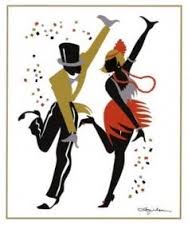While cutting shapes as a dance probably came from the “star” or challenge dances that were all part of the African-American dance called Juba, the particular sequence of steps which appeared in Runnin’ Wild were probably newly devised for popular appeal.”At first, the step started off with a simple twisting of the feet, to rhythm in a lazy sort of way (this could well be the Jay-Bird). When the dance hit Harlem, a new version was added. It became a fast kicking step, kicking the feet, both forward and backward and later done with a tap.” Further changes were undoubtedly made before the dance was put on stage. While the Charleston had some characteristics of traditional Negro dance, it was a synthetic creation, a newly-devised conglomerate tailored for wide spread popular appeal. Although the step known as “Jay-Bird”, and other specific movement sequences are of Afro-American origin, no record of the Charleston being performed on the plantation has been discovered.
Although it achieved popularity when the song “Charleston”, sung by Elisabeth Welch, was added in the production Runnin’ Wild, the dance itself was first introduced in Irving C. Miller’s Liza in the spring of 1923.
